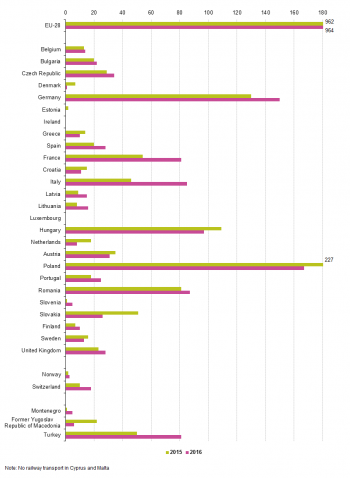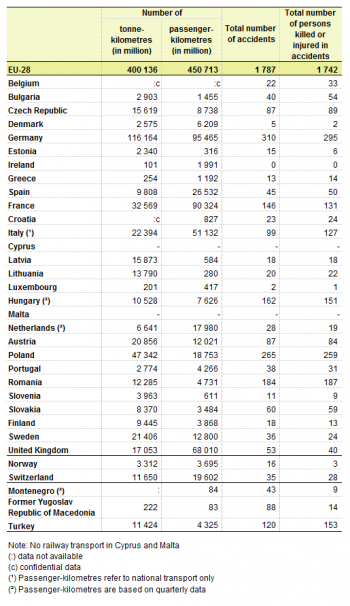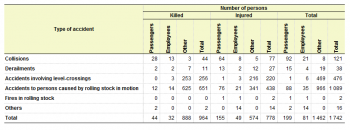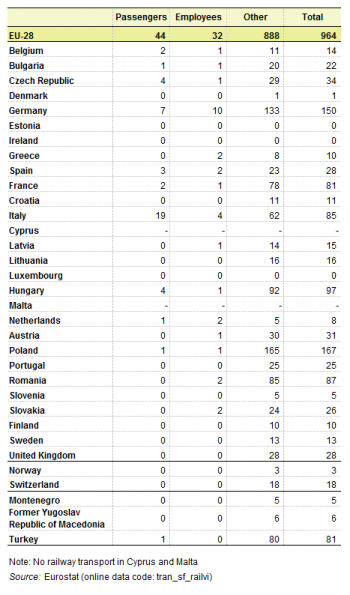Archive:Railway safety statistics
This article has been archived. For updated articles, please see here.
This article takes a look at recent annual statistics on rail transport accidents in the European Union (EU). Safety in rail transport has steadily enhanced over the years until 2013. However, in 2014 the number of accidents increased before dropping in 2015 and 2016 to the lowest levels registered. When considering the number of victims (killed or injured persons) the steady decline observed over the years stopped in 2016.

Source: Eurostat (tran_sf_railvi)
Main statistical findings

Source: Eurostat (tran_sf_railac) (tran_sf_railvi) (rail_go_grpgood) (rail_pa_typepas) (rail_pa_quartal)

Source: Eurostat (tran_sf_railvi) (rail_pa_typepas) (rail_pa_quartal)

Source: Eurostat (tran_sf_railvi)
Four Member States are responsible for more than half of the victims in the EU-28
In 2016, there were 1 742 persons killed or seriously injured in railway accidents in the EU-28. A 6 % increase compared with 2015 put an end to the constant enhancement in rail transport safety observed over the years. In detail, 964 persons were killed and 778 were seriously injured in 2016. In these 964 deaths, three countries accounted for 43 % of all deaths registered in the EU-28 in 2016, namely Germany, Hungary and Poland. Compared with 2015, fourteen countries registered an increase in the number of deaths; the highest increase was recorded in Italy, whereas the highest decrease was recorded in Poland. In 2016, Ireland and Luxembourg were the only two countries for which no deaths were registered, similarly to 2015 (Figure 1).
A total of 1 787 significant train accidents were registered in the EU-28 in 2016, representing a decrease of 0.9 % compared to 2015 and confirming the descending trend noted in 2015.
In absolute terms, four countries accounted for more than half of all rail victims registered in the EU-28 (killed or seriously injured) in 2016, namely Germany, Poland, Romania and Hungary (Table 1).
To measure the relative safety of rail transport, the number of accidents and the related number of victims have to be linked to traffic performance (expressed in passenger-kilometres and tonne-kilometres). When considering the average number of persons killed or injured per accident, the ratio is lower than or equal to 1.5 in all EU Member States, EFTA and Candidate countries; the ratio at EU level being 0.97.
Low number of fatalities per billion passenger-kilometres
When analysing the relation between passenger transport performance and rail safety using the number of passengers killed per passenger-kilometres, two countries recorded ratios of five times higher than the EU-28 average (0.10 passengers killed per billion passenger-kilometres). These Member States are Bulgaria (0.69) and Hungary (0.52).
All the other reporting countries recorded a ratio below 0.5 in 2016 (Figure 2). For a large majority of countries, this indicator increased or remained stable between 2015 and 2016. Only Bulgaria, the Czech Republic, France, Austria, Poland and Romania showed this ratio decrease in 2016 compared to 2015.
As the number of passengers killed in rail accidents is very low each year, it is important to keep in mind that one single accident - or even one single victim - can have a big impact when comparing countries or the annual number of passengers killed per billion passenger-kilometres.
Two types of accident caused 99 % of fatalities
The most common type of accident with victims related to accidents caused by rolling stock in motion in all reporting countries except the Czech Republic, Denmark, Slovenia, Finland and Turkey. In these countries accidents happening at level-crossings were the main cause of fatalities. In 2016, these two categories represented 90 % of the total amount of victims and 94 % of the fatalities (Table 2).
Only a minority (8 %) of rail accident victims in the EU-28 were actually passengers travelling on trains or railway employees. The majority, the remaining 92 %, was constituted of ‘other persons’ (e.g.: level-crossing users or unauthorised persons on railway premises).
At country level, 167 fatalities were registered in Poland, 150 in Germany and 97 in Hungary (Table 3). For these three countries, the majority of fatalities were linked to accidents caused by ‘rolling stock in motion’ (71 % for Poland, 74 % for Germany and 79 % for Hungary) (Table 4).
Within the EU-28, the highest share of fatalities due to collisions in the total number of fatalities was recorded in Italy (27 %), followed by Belgium (21 %).
Data sources and availability
Data availability
For EU Member States, Norway and Switzerland, the sources used for the statistics in this publication are data reported to the European Union Agency for Railways (ERA – www.era.europa.eu). Railway safety data have been collected by the ERA since 2006 through the Common Safety Indicators (CSIs). These were introduced by Annex I of the Railway Safety Directive (Directive 2004/49/EC). Member States have a legal obligation to submit their CSI data to the ERA. The Agency publishes an Overview of safety-related CSIs as soon as data are consolidated. The CSIs data are reported via, and available through ERAIL system at http://erail.era.europa.eu. The full set of CSI data are made available annually through the biennial Railway Safety Performance Report (paper and on-line) and the Safety Overview (on-line only). Eurostat has an agreement with the European Union Agency for Railways to disseminate the data through its dissemination database. The data available is a subset of data available at the Agency.
For Montenegro, the former Yugoslav Republic of Macedonia and Turkey, the figures have been collected according to Regulation (EC) No 91/2003, as they are not part of the agreement with the European Union Agency for Railways.
There is no railway in Cyprus and Malta.
Table 2 and Figure 2: Rail traffic performance is collected under the detailed reporting system, meaning that data include only main undertakings which are defined as follows:
- Until 2015: undertakings with a total transport performance greater than 500 million tonne-km or 200 million passenger-km.
- From 2016: undertakings with a total volume of goods transport of at least 200 million tonne-km or at least 500 000 tonnes or a total volume of passengers transport of at least 100 million passenger-km.
Railway undertakings which are below the thresholds may be included for some countries.
Basic results and derived indicators (such as growth rates and shares in % of total) in the tables are rounded. However, the figures are based on the non-rounded original data. As a result, the sum of shares in % of total, as shown in the tables, is not necessarily equal to 100 %.
Explanatory notes for countries are available in the metadata on the Eurostat website.
Definitions
Definitions presented here are those of the illustrated Glossary for Transport Statistics , chaper A.VII- Significant accidents.
- Significant accident
Any accident involving at least one rail vehicle in motion, resulting in at least one killed or seriously injured person, or in significant damage to stock, track, other installations or environment, or extensive disruptions to traffic. Accidents in workshops, warehouses and depots are excluded.
- Significant damage to stock, track, other installations or environment
This means damage that is equivalent to EUR 150 000 or more.
- Serious injury accident
Any accident involving at least one rail vehicle in motion, resulting in at least one killed or seriously injured person. Accidents in workshops, warehouses and depots are excluded.
- Level crossing accident
Any accident at level crossings involving at least one railway vehicle and one or more road vehicles, other users of the road such as pedestrians or other objects temporarily present at or near the track.
- Accident to persons caused by rolling stock in motion
Any accident to one or more persons that are either hit by a railway vehicle or part of it or hit by an object detached from the vehicle. Persons that fall from railway vehicles are included, as well as persons that fall or are hit by loose objects when travelling on-board vehicles.
- Person killed (Fatality)
Any person killed immediately or dying within 30 days as a result of an accident, excluding suicides. It includes passengers, employees and others persons specified or unspecified person involved in a rail injury accident.
- Person seriously injured
Any person injured who was hospitalised for more than 24 hours as a result of an accident, excluding attempted suicides.
- Rail passenger
Any person, excluding members of the train crew, who makes a trip by rail. For accident statistics, passengers trying to embark/disembark onto/from a moving train are included.
- Others
As a category of victim, "others" includes, for example, level crossing users and trespassers.
Symbols
| : | not available |
| - | not applicable |
| 0 | actual zero or very negligible transport |
| c | confidential data |
Context
The content of this statistical article is based on data collected by the European Union Agency for Railways which collects data under Annex I, Directive 2004/49/EC of the European Parliament and of the Council, information mentioned in the Regulation (EU) 2016/2032 of the European Parliament and of the Council paragraph 3.
See also
- Freight transport statistics - modal split
- Passenger transport statistics
- Railway freight transport statistics
- Railway passenger transport statistics - quarterly and annual data
- Transport accident statistics
Further Eurostat information
Publications
- Strong recovery in rail freight transport performance in the first nine months of 2010 - Statistics in focus 10/2012
- The fall in rail freight transport performance slowed down towards the end of 2009 - Statistics in focus 11/2011
- Goods transport by rail declining by the end of 2008 - Statistics in focus 19/2010
- Railway passenger transport decreased slightly at the beginning of 2009 - Statistics in focus 15/2010
Main tables
- Transport, see:
- Railway transport (t_rail)
- Rail transport of passengers (ttr00015)
Database
- Transport, see:
- Railway transport (rail)
- Railway transport measurement - passengers (rail_pa)
- Railway transport - accidents (rail_ac)
Dedicated section
Methodology / Metadata
Source data for tables and figures (MS Excel)
Other information
- Regulation (EC) No 91/2003 of 16 December 2002 on rail transport statistics
- Regulation (EC) No 1192/2003 of 3 July 2003 amending Regulation (EC) No 91/2003 on rail transport statistics
- For more data and metadata on rail accidents, please also see:
- Rail accidents by type of accident (ERA data) (tran_sf_railac):
- Rail accidents statistics (ESMS metadata file — tran_sf_rail_esms)

